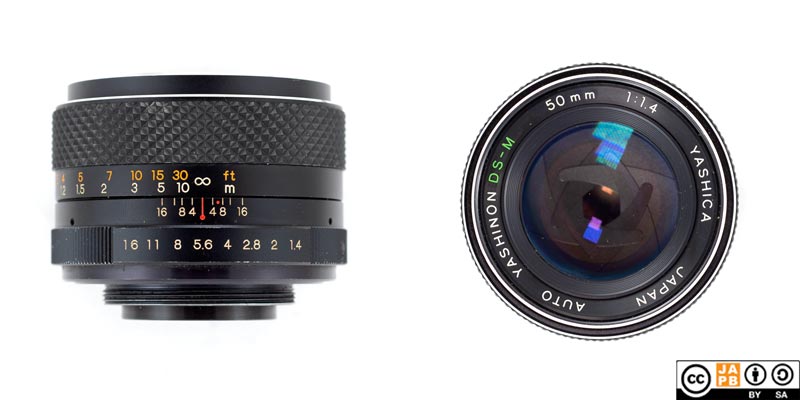Pekka Buttler, 12/2024

Specifications
The table below summarizes the lens’ key specifications (Measurements based on pictured sample):
| Brand: | Yashica | Lens name | Auto Yashinon DS-M 50mm 1:1.4 |
| Focal length(s)1 | 50 mm | Angle-of-view2 | 46 ° |
| Maximum Aperture | f/1.4 | In Production | 1971(?)–19753 |
| Lens mounts | M42 | Subfamily (if applicable) | DS-M |
| Length4 | 43,2 mm | Diameter5 | 63,7 mm |
| Filter ring diameter | 55 mm | Weight | 281 grams |
| Lens element count | 7 | Lens group count | 6 |
| Aperture blades (S/R/C)6 | 6 S | Focus throw | 185 ° |
| Minimum focusing distance | 50 cms | Maximum magnification | 1:7,9 |
| Has manual aperture ring | YES | Has Manual focus ring | YES |
| Aperture mechanism type: | Auto | Aperture click stops:7 | 1.4-2-2.8-4-5.6-8-11-16 |
Further notes:
• Between the short-lived Yashica Pentamatic mount (1959-61) and the relatively illustrious Contax-Yashica mount (1975->), Yashica used a standard M42 mount for its cameras and lenses.
• Yashica M42 era Yashica lenses were divided into four, mostly consecutive series (you can think of these as generations):
• Yashinon-R (preset lenses, single coated, many lenses hold-overs from the Pentamatic line)
• Auto Yashinon (DX) (automatic aperture, mostly single-coated)
• Auto Yashinon DS (automatic aperture, mostly single-coated)
• Auto Yashinon DS-M (automatic aperture, multicoated)
• Alike all DS-M generation Yashica lenses, this lens is auto-aperture only (depressing the stop-down pin is the only way to actuate the diaphragm).
• The Yashica Auto Yashinon DS-M 50 mm f/1.4 was the final fast fifty in the Yashica lens lineup before the launch of the Yashica ML 50/1.4 (for Contax/Yashica mount)
• Towards the end of Yashica’s involvement with the M42 lens mount, Yashica offered a comprehensive range of standard lenses from the slow(ish) fifty to the superfast fifty:
• DS Auto 50 mm f/2 (6 elements in 5 groups, likely discontinued in the early 70s)
• DS-M Auto 50 mm f/1.7 (6 elements in 6 groups)
• DS-M Auto 50 mm f/1.4 (7 elements in 6 groups) [this lens]
• DS-M Auto 55 mm f/1.2 (7 elements in 6 groups)
• It seems unclear whether Yashica offered any dedicated lens hoods for these primes, but as they are very rare today, it seems they did not come supplied with the lenses. If you need a lens hood for your lens, you can try a generic 55 mm thread lens hood for standard lenses.
• My sample of the Yashica Auto Yashinon DS-M 50 mm f/1.4 is considerably radioactive8.
Versions
I have no information of a significant redesign having happened during the life of this lens.
Adapting
If you want to natively mount this lens you need to find a functioning m42 mount film camera. Luckily that should be relatively easy as m42 bodies were produced in their millions and most of them lack features that are especially likely to have deteriorated to the point of making the entire camera inoperable.
Adapting this lens to a mirrorless, full-frame digital camera is a breeze thanks to the lens having full manual controls (aperture ring, focus ring). You simply need a dumb adapter from m42 to your mirrorless system, but be mindful of that your adapter should have an extra flange to actuate the aperture stop-down pin (otherwise you cannot stop down the lens).
Due to the medium flange focal distance used by the m42 mount (45,46 mm), whether you can adapt this lens to dSLR/SLR mounts depends on which dSLR mount: Canon EF, Four Thirds, Minolta/Sony A and Pentax K can mount m42 lenses using a simple adapter ring. Nikon F on the other hand is not as problem-free, and – to retain anything near infinity focus – the adapter will necessitate corrective optics. In all cases, your camera will work only in stop-down metering.
Footnotes
- Focal length is (unless stated otherwise) given in absolute terms, and not in Full-frame equivalent. For an understanding of whether the lens is wide/tele, see ‘Angle-of-view’. ↩︎
- Picture angle is given in degrees (based on manufacturers’ specs) and concerns the diagonal picture angle. Rule of thumb:
> 90 ° ==> Ultra-wide-angle
70–90 ° ==> Wide-angle
50–70 ° ==> Moderate wide-angle
40–50 ° ==> ‘Standard’ or ‘normal’ lens
20–40 ° ==> Short tele lens
10-20 ° ==> Tele lens
5-10 ° ==> Long tele lens
< 5 ° ==> Ultra-tele lens ↩︎ - While dating the end of production is relatively easy, the beginning of production is not as easy to ascertain with certainty, but likely late earliest 1970s. ↩︎
- Length is given from the mount flange to the front of lens at infinity. ↩︎
- Diameter excludes protrusions such as rabbit ears or stop-down levers. ↩︎
- S=straight; R=rounded; C=(almost)circular at all apertures. ↩︎
- Numbers equal aperture values on aperture ring; • intermediate click; – no intermediate click. ↩︎
- ‘considerably’ in this case indicates clearly measurable radioactivity that is clearly among the highest in its class. See the following JAPB article on radioactive lenses to learn more. ↩︎